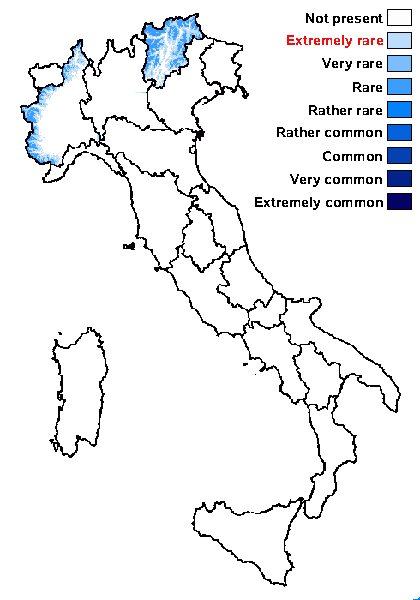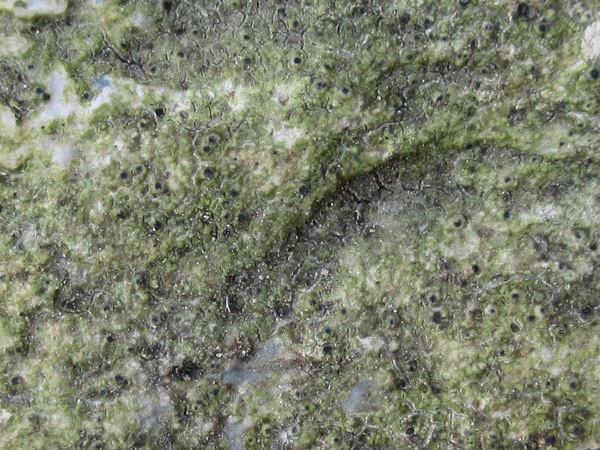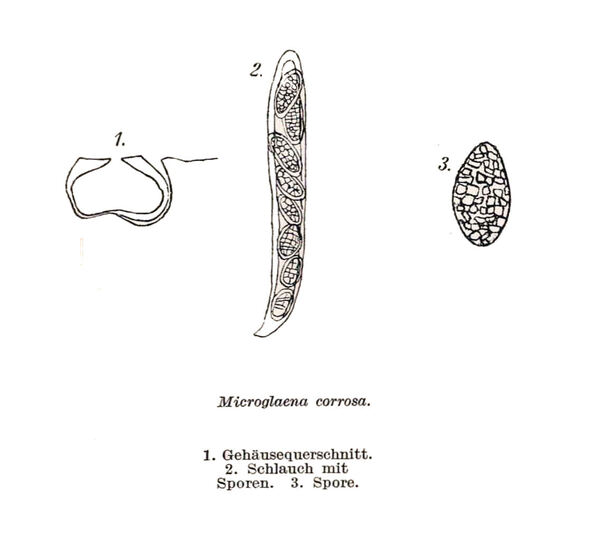Protothelenella corrosa (Körb.) H. Mayrhofer & Poelt
Herzogia, 7: 42, 1985. Basionym: Limboria corrosa Körb. - Syst. Lich. Germ.: 376, 1855.
Synonyms: Acrorixis corrosa (Körb.) Trevis.; Microglaena corrosa (Körb.) Arnold; Microglaena gibbosula (Nyl.) Blomb. & Forssell; Microglaena nericiensis Hellb.; Polyblastia arenaria (Hampe) Jatta; Thelenella corrosa (Körb.) Vain.
Distribution: N - TAA (Ohmura & Mayrhofer 2016, Nascimbene & al. 2022), Piem (Isocrono & al. 2004).
Description: Thallus crustose, smooth to granular-uneven, warted, or forming a cracked crust, often consisting of dispersed areoles surrounding the perithecia or poorly evident, whitish, dirty yellowish, green or brownish white. Perithecia 0.2-0.5 mm across, scattered, partly immersed, forming low to prominent, black projections, the apex often with a small central depression. Exciple dull greenish brown to dark brown in upper part, colourless to very pale brown towards the base, of strongly anastomosing, up to 1 μm wide, conglutinate hyphae with narrow lumina; paraphysoids thread-like, c. 1 μm thick, persistent, strongly branched and anastomosing; periphysoids absent; hymenial gel I+ reddish or I+ blue at low concentrations, K/I+ blue. Asci 8-spored, cylindrical, short-stalked, thick-walled (2-3 μm), fissitunicate, the outer gelatinous wall layer I+ blue, with a very faintly I+ blue apical plug. Ascospores muriform, hyaline, broadly ellipsoid to ovoid, (16-)18-32 x (8-)10-15(-18) μm, the outer wall distinctly thicker than the septa. Photobiont chlorococcoid (Elliptochloris), the algal cells surrounded by a gelatinous sheath. Spot tests: thallus K-, C- or C+ red, KC- or KC+ red, P-. Chemistry: an unidentified C+ red pigment in thallus.Note: an arctic-alpine to boreal-montane, probably circumpolar lichen found on slightly calciferous rocks, especially by creeks and lakes, on boulders and pebbles near the ground; much overlooked and certainly more widespread in the Alps, with optimum above treeline.
Growth form: Crustose
Substrata: rocks
Photobiont: green algae other than Trentepohlia
Reproductive strategy: mainly sexual
Most common in areas with a humid-warm climate (e.g. most of Tyrrenian Italy)
Commonnes-rarity: (info)
Alpine belt: rare
Subalpine belt: very rare
Oromediterranean belt: absent
Montane belt: extremely rare
Submediterranean belt: absent
Padanian area: absent
Humid submediterranean belt: absent
Humid mediterranean belt: absent
Dry mediterranean belt: absent

Predictive model
Herbarium samples
Growth form: Crustose
Substrata: rocks
Photobiont: green algae other than Trentepohlia
Reproductive strategy: mainly sexual
Most common in areas with a humid-warm climate (e.g. most of Tyrrenian Italy)
Commonnes-rarity: (info)
Alpine belt: rare
Subalpine belt: very rare
Oromediterranean belt: absent
Montane belt: extremely rare
Submediterranean belt: absent
Padanian area: absent
Humid submediterranean belt: absent
Humid mediterranean belt: absent
Dry mediterranean belt: absent

Predictive model
| Herbarium samples |
 Index Fungorum
Index Fungorum
 GBIF
GBIF



